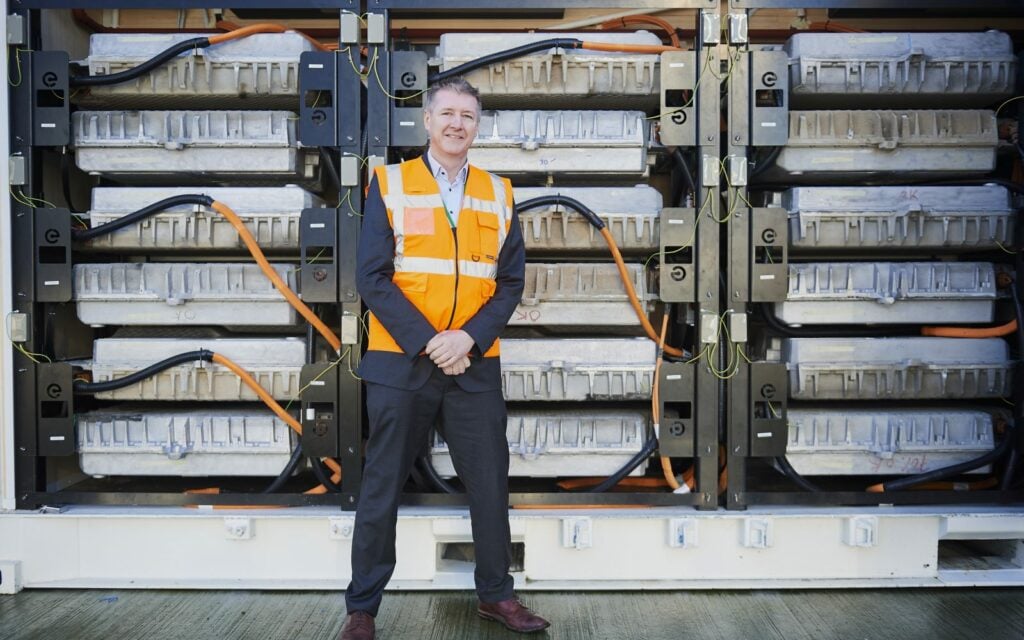
Matthew Lumsden, CEO of second life application battery energy storage solution (BESS) provider Connected Energy, talks Energy-Storage.news through scaling up the business in preparation for an EV boom from 2024/2025.
The UK-based firm raised £15 million (US$18.4 million) from five new investors to scale up its business last week, as reported by Energy-Storage.news. The company was founded in 2015 and develops and designs BESS units using second life batteries from electric vehicles (EVs), with Renault its main supplier to-date.
Enjoy 12 months of exclusive analysis
- Regular insight and analysis of the industry’s biggest developments
- In-depth interviews with the industry’s leading figures
- Annual digital subscription to the PV Tech Power journal
- Discounts on Solar Media’s portfolio of events, in-person and virtual
Or continue reading this article for free
With the help of subcontracted assemblers, it collates the batteries into blocks or modules made up of one type of battery with the same shape, size and cooling needs, and aggregates blocks into whole BESS units. Its key building block is a 360kWh unit made up of 24 Renault Kangoo van batteries and has mostly been deployed in commercial & industrial (C&I) settings.
Its latest fundraise round included subsidiaries of Caterpillar and Volvo Group, which manufacture large EVs and will be able to provide Connected Energy with batteries.
As reported last week, here, Lumsden says the latest fundraise round is about scaling up the size of the company’s product to a utility-scale offering in order to be ready for 2025 onwards, when the number of EVs on the road – and associated second life battery availability – really takes off.
“We’ve raised enough cash to build a 40MWh system that will demonstrate the technology at scale, but then also prove some of the new business models which we think you need to scale up second life energy storage,” Lumsden says.
“So it’s really about getting a bankable business model in place, whereby come 2025 when the real volumes of batteries start to come into play, we’ve got a proven technology and a proven business model that infrastructure investors will back, so that we can really start to build out some larger scale systems.”

The new 20MW/40MWh utility-scale offering will be called M-STOR. Lumsden wouldn’t be specific but says it is looking at sites in the UK and Europe for its first deployment. “It’s not just a demonstration system, it’s a commercial system, so it’s about getting the best deal.”
A big part of the second life application business model for utility-scale, he says, centres around the relationship with suppliers to ensure a ‘flow of batteries’ and performance guarantees that will carry through a system’s 30-year lifetime, and a cost model that is competitive and attractive relative to ‘first life’, i.e. new battery-based systems. Another aspect is having a good BMS (battery management system) since batteries will not be uniform.
Lumsden: “Our secret sauce is all about having a BMS that communicates with 1,000 batteries, all of which have slightly different states of health and some of which might come from different manufacturers. It’s all about how you control them and aggregate them all as one system relative to their respective states of health, performance, characteristics, costs, etc.”
Connected Energy is also implementing AI into its algorithms to learn more about how batteries behave, both to optimise its systems technically and commercially but also track and isolate anomalies, he adds.
When asked what changes he’d like to see from the wider industry to make developing and deploying second life-based solutions easier for companies like his, Lumsden makes an interesting point around safety standards.
“The key next step is really to get some good standards around second life batteries, so that they’re being used by people who are using them safely and you’re managing the risks associated with second life batteries. We need to get to the point where there’s a bit of regulation and safety parameters around operating systems using second life, as there isn’t any specific regulation around it at the moment,” he says.
“I think it’s important that we get to a point where second life systems are being developed according to certain standards by people who understand how to do it, so that we mitigate the risk of any thermal event? A big, big focus from us has been absolute safety, so we will only use batteries if the OEM will collaborate with us and they have to be happy with the way we’re doing what we do.”
Today, Connected Energy has deployed systems in the UK, Belgium, Netherlands and Germany and wants to expand in Europe and eventually into the US too, which would require partnering with a local system integrator to carry out the assembly process there.
